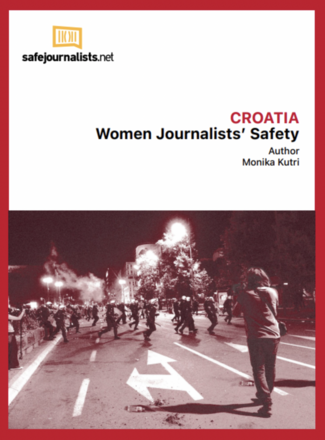
This report is focused on women journalists’ safety in Croatia, who continue to face various forms of violence in Western Balkans– from physical to psychological violence. The first two chapters (introduction and methodology) address the scope, the structure and the research methodology of the report. The third chapter provides an international framework on safety of women journalists and gender-based violence. In particular, it explains how violence against women journalists globally affects media organizations. Moreover, journalists with intersecting identities who cover sensitive topics such as conflict and human rights abuses encounter heightened risks undermine pluralism and democratic effectiveness.
Croatia takes part in different international legal instruments that tackle gender-based violence: the CEDAW, the Istanbul Convention, the UN Plan of Action on the Safety of Journalists, the UN General Assembly Resolution 72/175. The EU has stressed the need for serious responses by Member States and it has adopted various legal instruments. The Directive 2024/1385 imposes obligations on Member States to adopt policies that safeguard women journalists from harassment and abuse – both online and offline. Notwithstanding these international commitments, gender-based violence on journalists remains a critical issue in Croatia. The national framework still lacks complete guarantees and mechanisms for reporting abuses, threats etc. Despite some progress, effective gender equality has still to be reached in Croatia. Indeed, this report highlights that 20 cases of violence occurred against women journalists in Croatia from 2021 to 2024. Specifically, Safejournalists.org database registered: a) 7 physical attacks; b) 3 death threats; c) 10 other forms of threat. However, the chapter dedicated to qualitative analysis clearly shows that in several cases women often choose not to report intimidations, because of inadequate institutional support. The last report’s chapter is dedicated to recommendations to institutions, media companies and civil society and it stresses the need for further national reforms in the country.
Institutions should: a) establish specialized training for police and judiciary units to tackle gender-based violence on women journalists; b) guarantee independent investigations in public institutions and public media; c) improve the timing for application of precautionary measures when threats occurs; d) provide financial and legal support for women journalists without institutional protection.
Media companies should: e) ensure protection from digital threats, preserving victim’s identity and anonymous reporting; f) introduce education on gender equality and recognition of gender-based violence for all employees.
Civil society and journalists’ associations should: g) promote the development of solidarity networks among women journalists and fostering exchange of experiences and support in crisis situation; h) constantly produce report on gender-based violence in order to monitor trends and the effectiveness of the measures applied
Tags: Croatia Safety of journalistsThe content of this article can be used according to the terms of Creative Commons: Attribution-NonCommercial 4.0 International (CC BY-NC 4.0) . To do so use the the wording "this article was originally published on the Resource Centre on Media Freedom in Europe" including a direct active link to the original article page.

